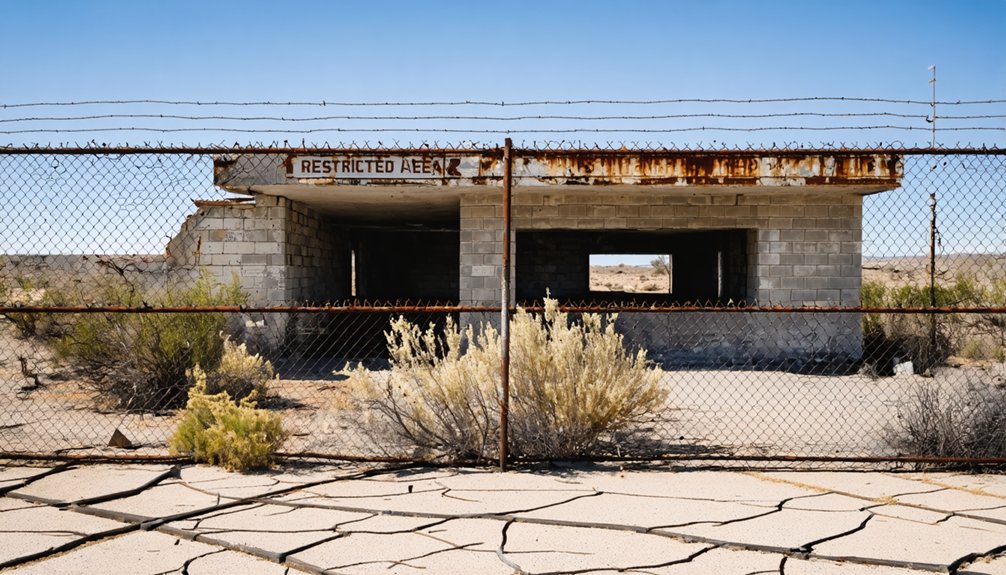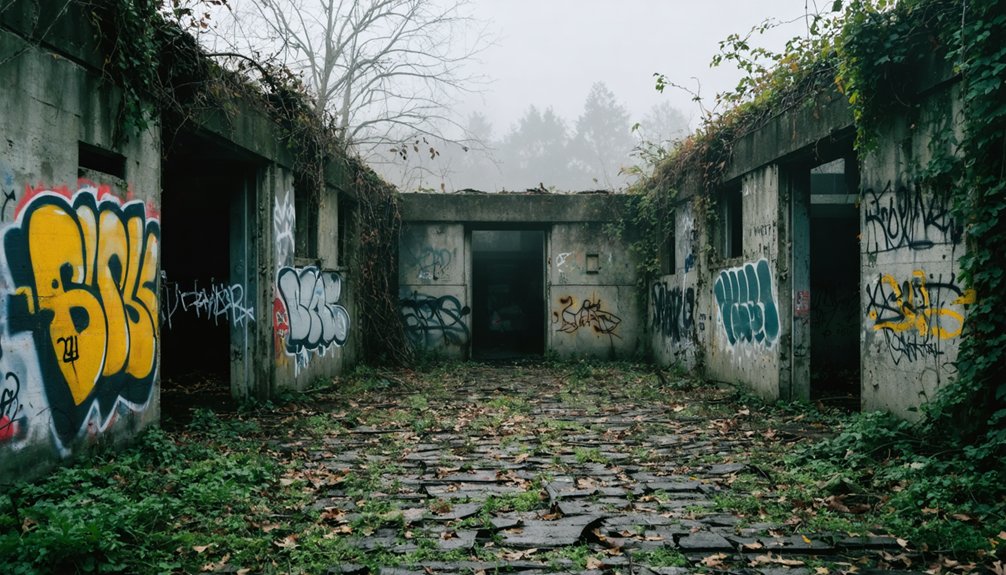Forgotten defense base ghost towns are abandoned military installations that once protected America’s borders from the Revolutionary War through the Cold War. You’ll find deteriorating bunkers, barracks, and infrastructure at sites like Fort Tilden, Devils Slide Bunker, and decommissioned missile complexes. These sites often left behind toxic environmental legacies requiring millions in cleanup costs while displacing surrounding communities. Many bases now serve as historical markers or have transformed into civilian spaces, preserving their military heritage for future generations to explore.
Key Takeaways
- Forgotten defense base ghost towns are abandoned military settlements that once supported installations but declined following base closures or strategic changes.
- These towns typically feature deteriorating infrastructure, from crumbling bunkers and barracks to vacant family housing units and overgrown parade grounds.
- Military ghost towns like Babbitt, Nevada emerged to serve defense needs but were later abandoned when their strategic purposes became obsolete.
- The end of major conflicts and the Cold War led to widespread base closures through BRAC, transforming once-thriving military communities into deserted areas.
- These abandoned sites often leave environmental contamination legacies requiring extensive remediation while preserving historical elements of America’s military past.
The Birth and Fall of Military Installations
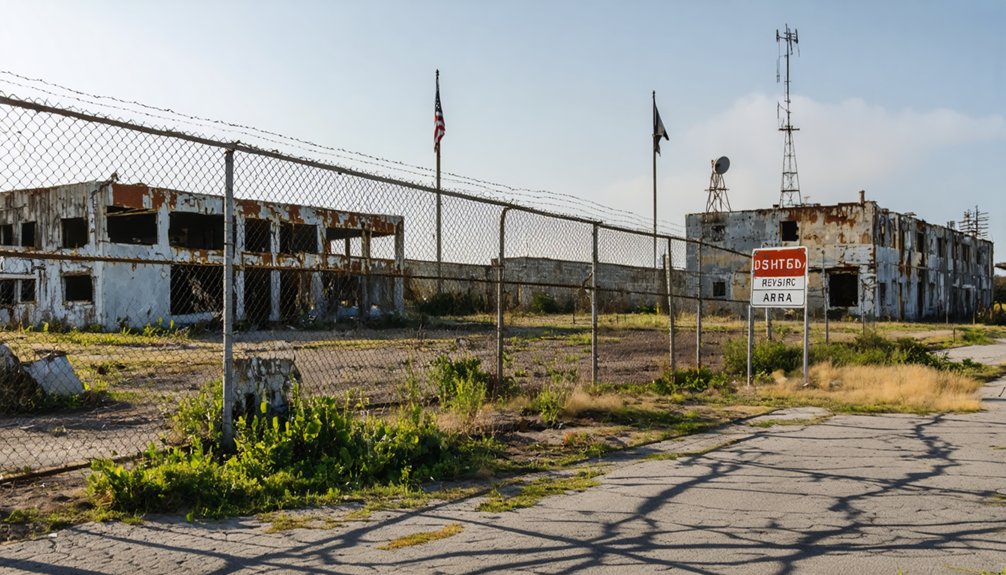
As America emerged from its revolutionary struggles, the nascent military establishment began constructing permanent installations to defend the young nation’s borders and strategic interests.
Early frontier outposts like Fort Pitt evolved into established bases such as West Point, while naval facilities emerged in Boston and Norfolk.
This military evolution accelerated during major conflicts, with World War I spawning Camp Jackson and World War II generating numerous air bases like Andrews and Dover. The Bureau of Yards and Docks constructed naval public works worth over $9 billion during World War II, significantly expanding the Navy’s shore establishment. The economic benefits of these military posts often prevented their early abandonment despite changing strategic needs.
Historical Defense Ghost Towns Across America
You’ll find America’s landscape dotted with abandoned military installations that once bustled with strategic defense activities from the War of 1812 through the Cold War.
These deteriorating sites, ranging from coastal fortifications like Fort Tilden to inland training centers such as Fort Ord, represent significant historical markers of America’s evolving defense priorities and technological advancements.
The advanced state of decay at many locations—characterized by crumbling bunkers, collapsed barracks, and overgrown parade grounds—presents both preservation challenges and compelling glimpses into the nation’s military past.
The Devils Slide Bunker in San Mateo County stands as a stark reminder of coastal defense points established during World War II to protect San Francisco harbor from potential Japanese attacks.
Fort Worden in Washington state was converted into a multi-use state park in 1973, offering visitors a chance to explore its moss-covered batteries and empty beaches.
America’s Defense Detritus
Scattered across the American landscape, from coastal watchtowers to remote mountain installations, lies a peculiar category of ghost towns birthed not by failed economic ventures but by shifting military priorities.
You’ll find these military heritage sites frozen in time—North Truro Air Force Station (1951-1994) with its abandoned radar facilities, and Fort Ord, California, which trained over one million personnel before its 1994 closure.
Explore forgotten defensive structures like the Titan I Missile Complex near Royal City, with its massive reinforced doors and tunnel networks.
These Cold War relics often contain kitchen supplies, tools, and other artifacts left when strategic priorities changed. Many sites feature clear distinction between housing for enlisted personnel and officers, reflecting military hierarchy preserved in abandonment.
Fort Jefferson and Fort Monroe exemplify coastal defenses now crumbling from neglect. Visitors to Fort Monroe may experience encounters with Jefferson Davis’s ghost reportedly seen wandering near his former prison cell.
Be cautious—these ghost towns harbor environmental hazards including asbestos, lead paint, and structural decay.
Military Towns Gone Silent
Military towns across America followed a distinct lifecycle, rising to meet urgent defense needs and falling into abandonment when their strategic value diminished.
You’ll find forgotten legacies in places like Babbitt, Nevada, constructed in 1941 to support the Hawthorne Naval Ammunition Depot—once the world’s largest.
These communities weren’t merely barracks but planned residential developments with standardized duplex housing for entire families.
Fort Bowie, established in 1862 after the Apache Pass Battle, protected essential water sources while serving travelers until 1894.
Silent echoes remain where thousands once worked.
Babbitt expanded from 25 units to over 425 within a year as wartime production surged.
When Congressional budget decisions, technological advances, and reduced military operations converged, these purpose-built communities emptied, leaving behind America’s defense infrastructure ghosts.
Like many abandoned mining towns, these military settlements often declined due to resource depletion when their strategic function was no longer needed.
Many of these sites are maintained in a state of decay similar to Bodie, California, allowing visitors to witness authentic remnants of America’s military history.
Why These Military Bases Were Abandoned
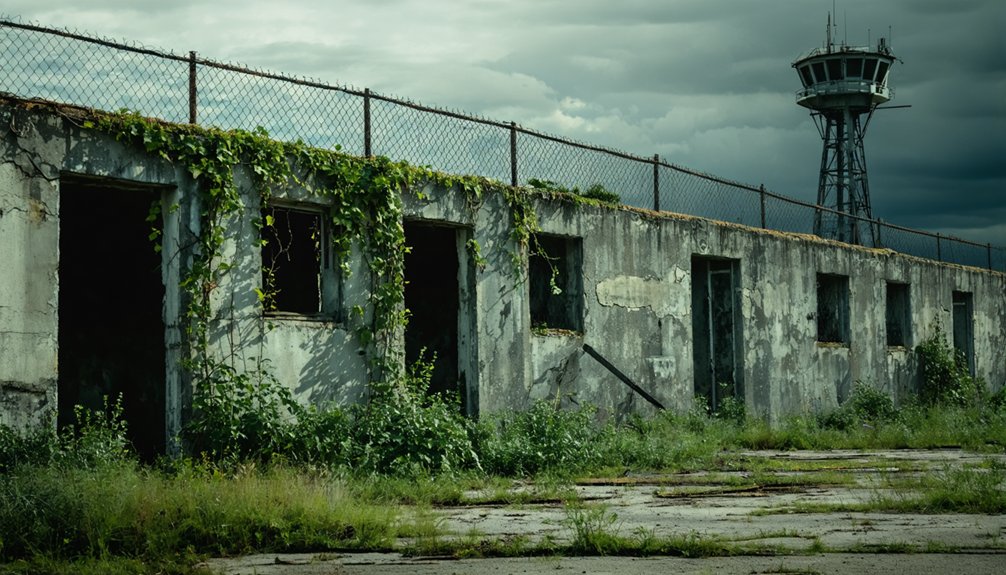
While the Cold War’s end prompted a major reassessment of America’s defense infrastructure, the abandonment of military bases across the United States stemmed from multiple converging factors beyond simple geopolitical shifts.
The Department of Defense initiated national downsizing in the late 1980s, establishing the Base Realignment and Closure Commission (BRAC) to systematically evaluate installations. Through five congressional-authorized rounds (1988-2005), 424 bases faced closure or realignment due to fiscal inefficiency, excess capacity, and outdated infrastructure. DOD reports estimated 22% excess capacity across all military infrastructure by 2017, highlighting the continuing problem of maintaining unnecessary facilities.
America’s defense downsizing wasn’t accidental. BRAC methodically pruned 424 bases through five rounds of strategic evaluation.
You’ll find economic impacts were severe—the Bay Area alone lost 45,000 jobs. The closure of Mare Island in 1996 was particularly devastating, contributing to significant economic challenges for Vallejo that persist today.
Environmental contamination often complicated changes, with 34 installations becoming Superfund sites. Local tensions from noise complaints, housing scarcity, and competing civilian infrastructure needs further influenced base closure decisions.
Ultimately, these abandoned installations represent the intersection of strategic obsolescence and practical unsustainability.
Exploring the Remains: Structures and Artifacts
These abandoned bases now stand as time capsules of American military architecture and technology, their weathered structures silently narrating decades of strategic defense history.
You’ll find massive aircraft hangars spanning over 1,000 feet alongside concrete bunkers with reinforced openings designed to withstand bombardment.
Venture through abandoned barracks where personal items—uniforms and letters—remain frozen in time, offering glimpses into servicemembers’ daily lives.
Many bases reveal hidden tunnels connecting underground command centers with 14-foot-thick walls and blast doors.
These subterranean networks, often extending several acres, housed missile silos descending 155 feet below ground.
Coastal defense batteries feature gun emplacements and observation posts, while decommissioned aircraft rust on forgotten runways.
Technical equipment—radios and radar components—sits untouched, awaiting rediscovery by those seeking America’s military heritage.
Lives Interrupted: Communities Affected by Base Closures

When a military installation shutters its gates, the economic aftershocks ripple through surrounding communities with devastating precision.
You’ll witness immediate job losses, plummeting tax revenues, and declining school enrollments as military families relocate. Businesses dependent on base personnel face customer shortfalls while public services suffer from reduced funding.
Despite initial hardships, community resilience often emerges within a decade post-closure. Urban areas typically demonstrate faster economic adaptation than rural regions, with unemployment dropping 0.89 percentage points relative to national trends.
Success factors include early planning, decisive leadership, and diversification strategies.
Your community’s trajectory depends largely on pre-existing economic conditions and redevelopment approaches.
While public perception has shifted from opposition to cautious acceptance, persistent challenges remain for communities experiencing “stealth closures” without adequate support systems for adjustment.
Environmental Legacy and Contamination Challenges
You’ll find the environmental footprint of closed military installations manifests through pervasive toxic waste contamination, with nearly 900 abandoned military sites designated as Superfund locations.
The ecological recovery patterns following base closures reveal disturbing contamination profiles, including PFAS levels reaching as high as 1,916,859 parts per trillion at Holloman Air Force Base.
Despite ongoing remediation efforts at locations like Wurtsmith and Hill Air Force Bases, cleanup timelines frequently stretch across decades, with estimated costs reaching tens of millions while surrounding communities continue experiencing elevated cancer rates and persistent groundwater pollution.
Toxic Waste Remains
Long after military personnel and their families vacated these defense base ghost towns, a toxic environmental legacy continues to haunt the landscape through widespread contamination.
You’ll find groundwater polluted with benzene, TCE, and PFAS migrating toward essential water bodies, with nearly 400 drinking wells at Wurtsmith Air Force Base testing positive for these chemicals.
The toxic exposure extends beyond boundaries into surrounding communities, with 1,400+ contaminated sites nationwide requiring decades of remediation.
Cleanup costs are staggering—$72 million estimated for Wurtsmith alone.
Meanwhile, the contamination effects manifest in alarming health statistics: Fort Ord veterans show 35% higher rates of multiple myeloma, and approximately 400 former residents have developed cancer.
Despite EPA Superfund designations beginning in 1990, many sites remain hazardous indefinitely.
Ecological Recovery Patterns
While toxic contamination represents the darkest aspect of these abandoned military sites, nature’s resilience manifests through complex ecological recovery patterns that unfold across the landscape.
You’ll notice species composition gradually converging toward pre-disturbance conditions through ecological succession, with recovery rates varying from 22.7% to 95.1% similarity to undisturbed sites.
Recovery trajectories are greatly influenced by soil development—sites with well-developed argillic B horizons and Stage I-II K horizons revegetate more slowly.
Military brownfields present layered challenges, as unexploded ordnance and chemical residues complicate restoration efforts.
Geomorphic surface age introduces additional variability; older surfaces with complex soil profiles exhibit less predictable recovery patterns.
Most species show statistically significant responses to historic disturbances, with recovery influenced by both disturbance type and intensity.
Remediation Efforts Today
Decades after the closure of military bases across the nation, remediation efforts continue to address the toxic legacies left behind at these forgotten defense ghost towns.
At Rantoul Air Force Base, over $200 million has been invested with $76.4 million still needed as cleanup reaches 85% completion. Remediation strategies include asbestos removal from steam lines and ongoing treatment of multiple toxic substances.
Meanwhile, the DoD has extended cleanup timelines for PFAS “forever chemicals” at more than 100 sites nationwide.
Cleanup challenges are compounded by deteriorating infrastructure where hazardous materials remain embedded in crumbling buildings. Multiple regulatory agencies oversee these efforts under CERCLA requirements, though compliance deadlines face postponements.
At bases like Stewart Air National Guard, even installed filtration systems become overwhelmed by environmental conditions, necessitating continuous adaptation of remediation approaches.
Preservation Efforts and Historical Documentation
Despite their abandoned status, decommissioned military installations across America have become focal points for extensive preservation and documentation efforts.
You’ll find Spanish Mission Revival architecture at Hamilton Field preserved alongside Fort Barry’s oak balustrades and maple floors now repurposed as art spaces. Historical documentation reveals complex preservation challenges, including asbestos warnings at North Truro Air Force Station and PCB contamination at Finland’s Superfund site.
The Golden Gate National Recreation Area has partnered with Headlands Center for the Arts since 1986, while Galveston Island maintains original fortifications.
Physical documentation captures abandoned on-site housing with kitchen supplies untouched, and officer’s quarters with garage tools still in place. The Presidio’s 500 historic buildings span two centuries of military history, offering chronological evidence of America’s defensive evolution under three different national flags.
From Military Outposts to Modern Repurposing
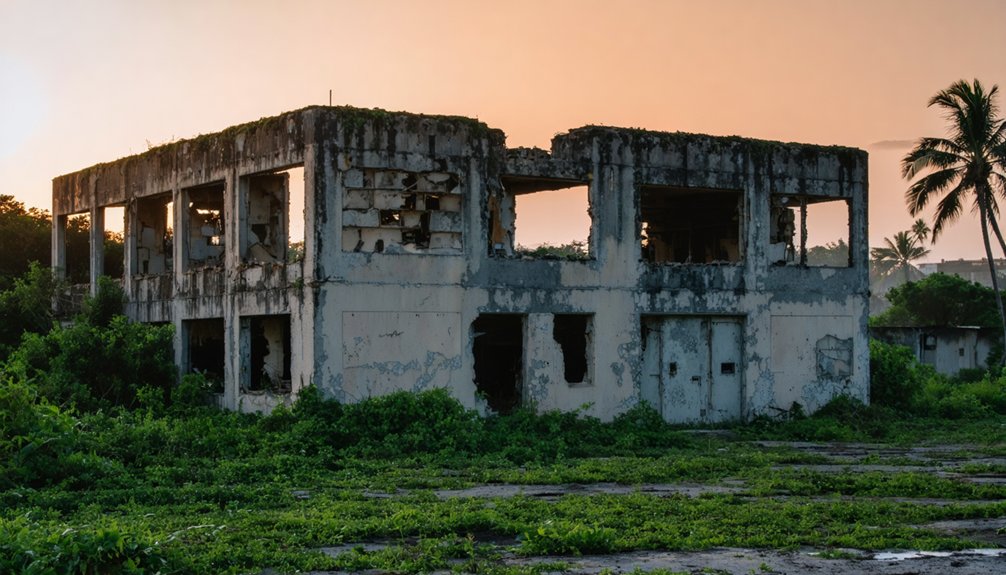
The transformation of America’s abandoned military installations into functional civilian spaces represents one of the most significant land repurposing projects in national history.
You’ll find remarkable military transformation at sites like the Presidio and Fort Mason, which evolved from strategic defense positions into vibrant mixed-use developments combining residential, commercial, and recreational spaces.
Glasgow Air Force Base exemplifies Cold War-era urban adaptation, where former barracks now house the Mountain-Plains education program teaching industrial skills.
Roosevelt Roads Naval Base, once home to 15,000 personnel, and Mare Island’s 5,000 acres demonstrate varied repurposing approaches.
Despite contamination challenges—with Roosevelt Roads’ surrounding areas absorbing 662 million pounds of explosives—communities like St. Marie emerged from military ruins, though harsh climate conditions limited success.
Hamilton Air Force Base stands as a successful housing redevelopment model.
Frequently Asked Questions
Are There Any Haunted Defense Ghost Towns With Paranormal Activity?
You’ll find haunted locations at Fort Leavenworth, Francis E. Warren AFB, Fort Monroe, and Kadena AB, where paranormal investigations regularly document apparitions, disembodied voices, and unexplained phenomena dating to their military operations.
Can Civilians Legally Visit or Photograph Abandoned Military Ghost Towns?
You can legally visit some abandoned military ghost towns with proper authorization. Civilian access varies by site ownership, while legal restrictions require you to obtain permits before photographing these historically significant locations.
What Valuable Items Have Been Recovered From Defense Ghost Towns?
Like forgotten time capsules, you’ll find recovered artifacts including rare coins, military equipment, and valuable memorabilia such as Cold War scientific instruments, Wells Fargo artifacts, and personal effects from hurried evacuations.
Do Any Defense Ghost Towns Still Contain Classified Military Technology?
Yes, you’ll find classified artifacts within restricted zones of partially decommissioned sites. Military secrets persist in secured bunkers, abandoned radar installations, and contaminated areas where cleanup operations weren’t fully completed.
Have Movies or TV Shows Been Filmed in Abandoned Military Bases?
Yes, you’ll find numerous films shot at abandoned bases like Castle Air Force Base, where intact runways offer authentic military history backdrops for productions including “Iron Man 2” and “Skyfall.”
References
- https://www.sdpb.org/rural-life-and-history/2023-08-21/some-black-hills-ghost-towns-and-their-origins
- https://en.wikipedia.org/wiki/Ghost_town
- https://doc.searls.com/2016/06/29/desert-warfare-training-in-live-ghost-towns-seen-from-the-sky/
- https://abandonedwonders.com/2016/08/18/cold-war-ghost-town-the-abandoned-truro-air-force-station/
- https://www.youtube.com/watch?v=3d4bUMUUWxY
- https://www.youtube.com/watch?v=c8cqQ-q7t9E
- https://www.loveexploring.com/gallerylist/233478/americas-eeriest-abandoned-military-sites
- https://www.usafa.af.mil/News/Features/Display/Article/429717/ghost-town-recalls-life-in-golden-era/
- https://www.wearethemighty.com/mighty-history/9-military-ghost-bases-youve-probably-never-heard-of/
- https://www.amc.af.mil/Portals/12/documents/AFD-131018-055.pdf
